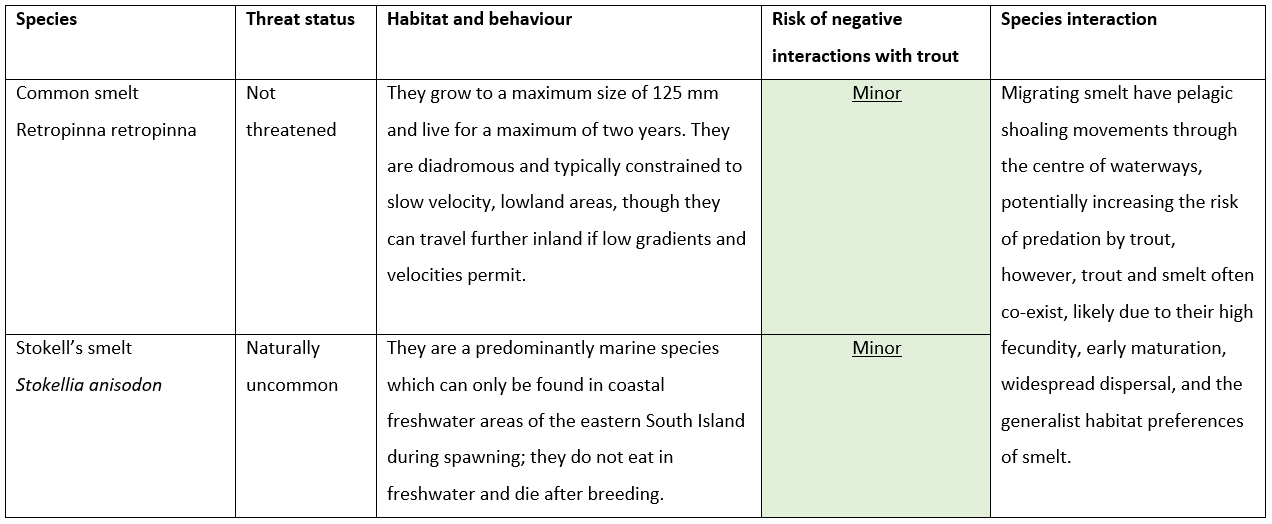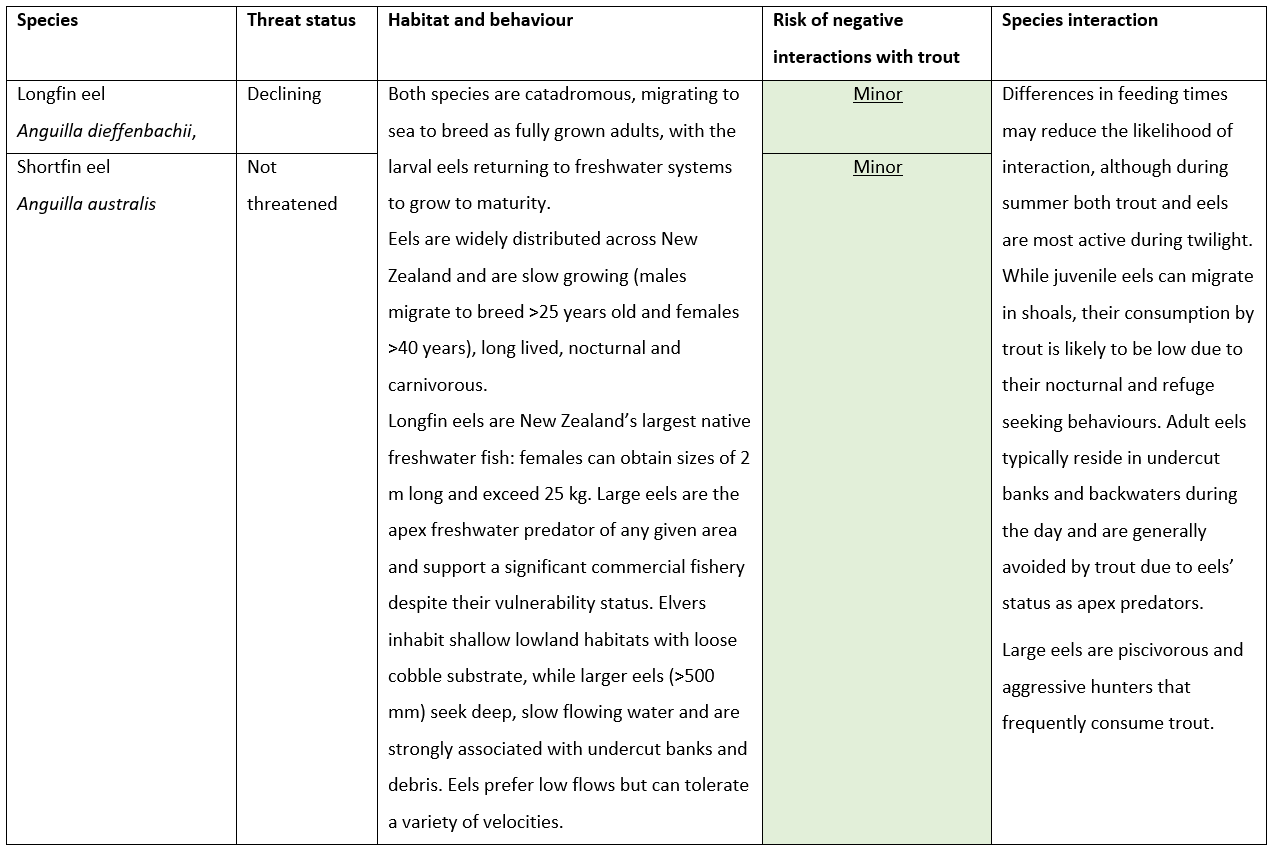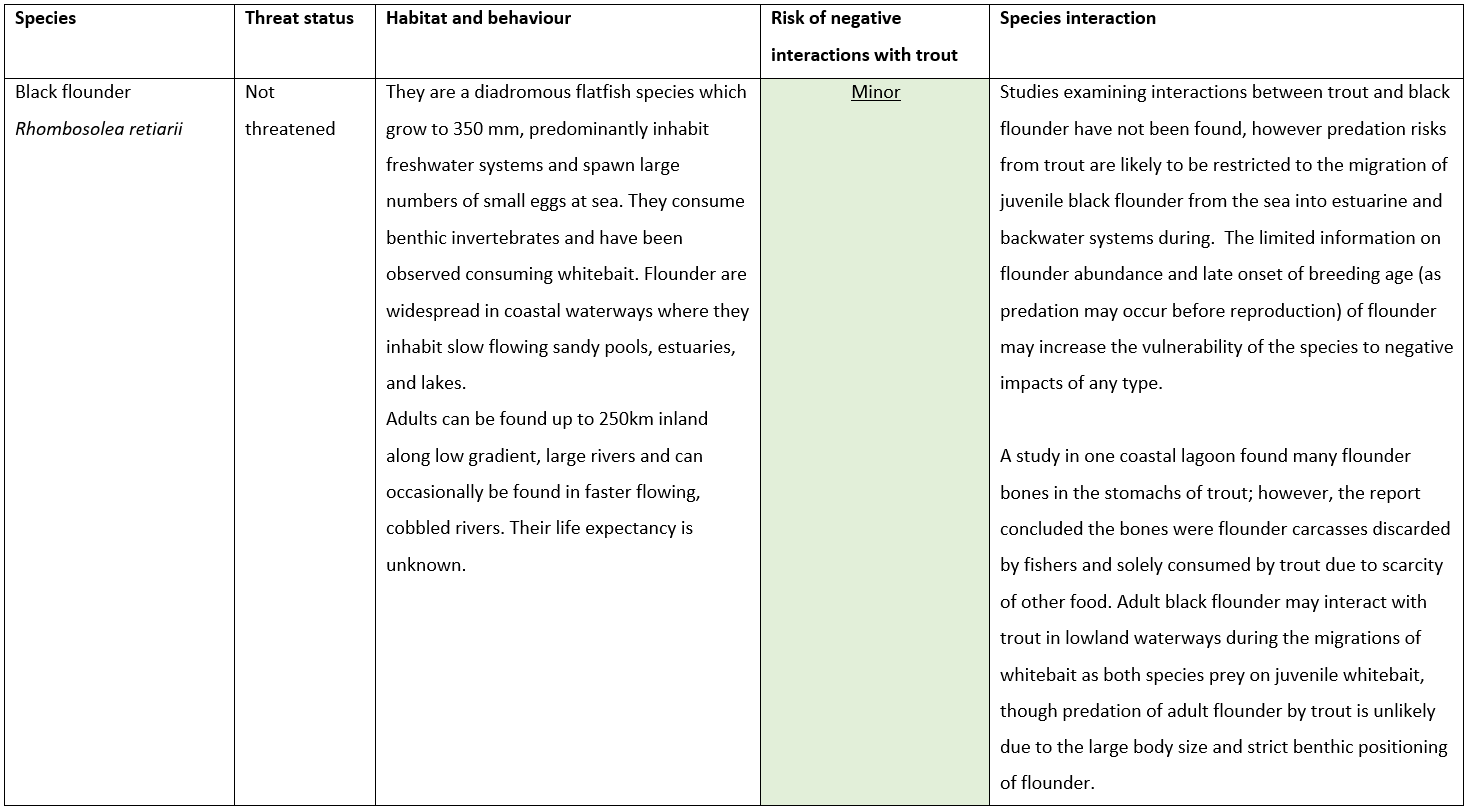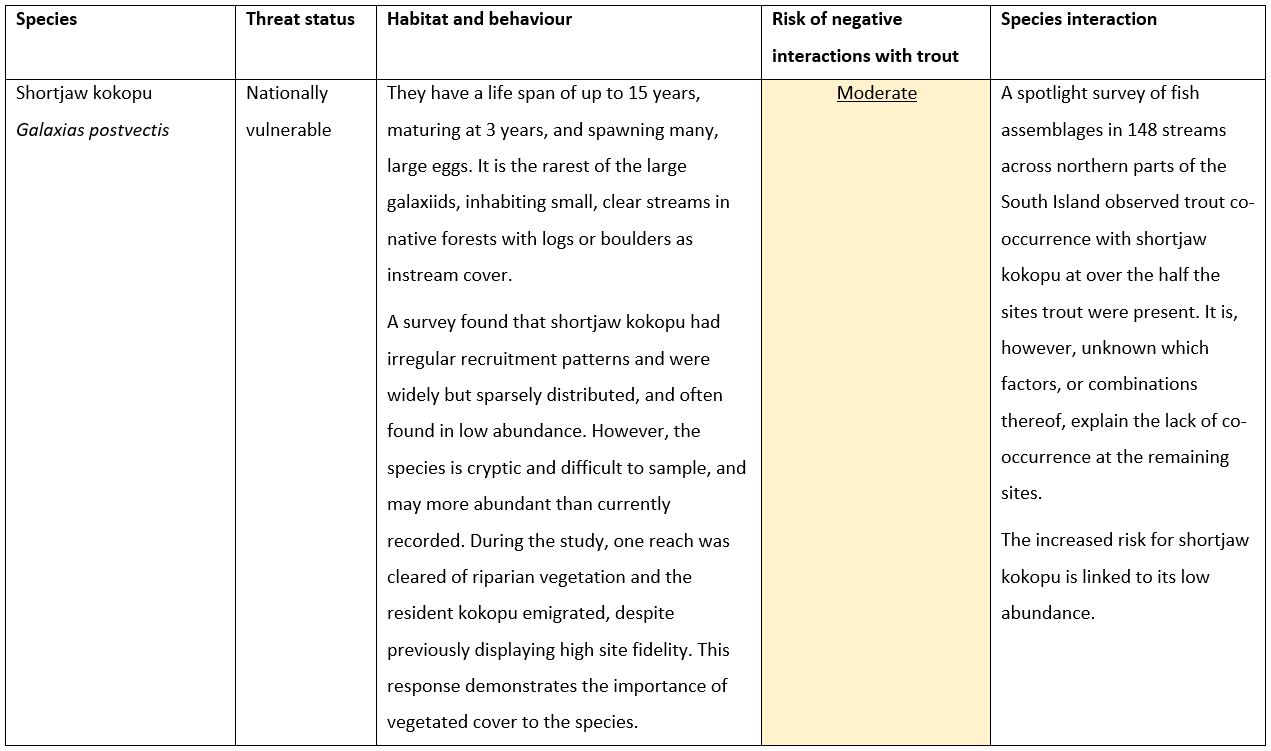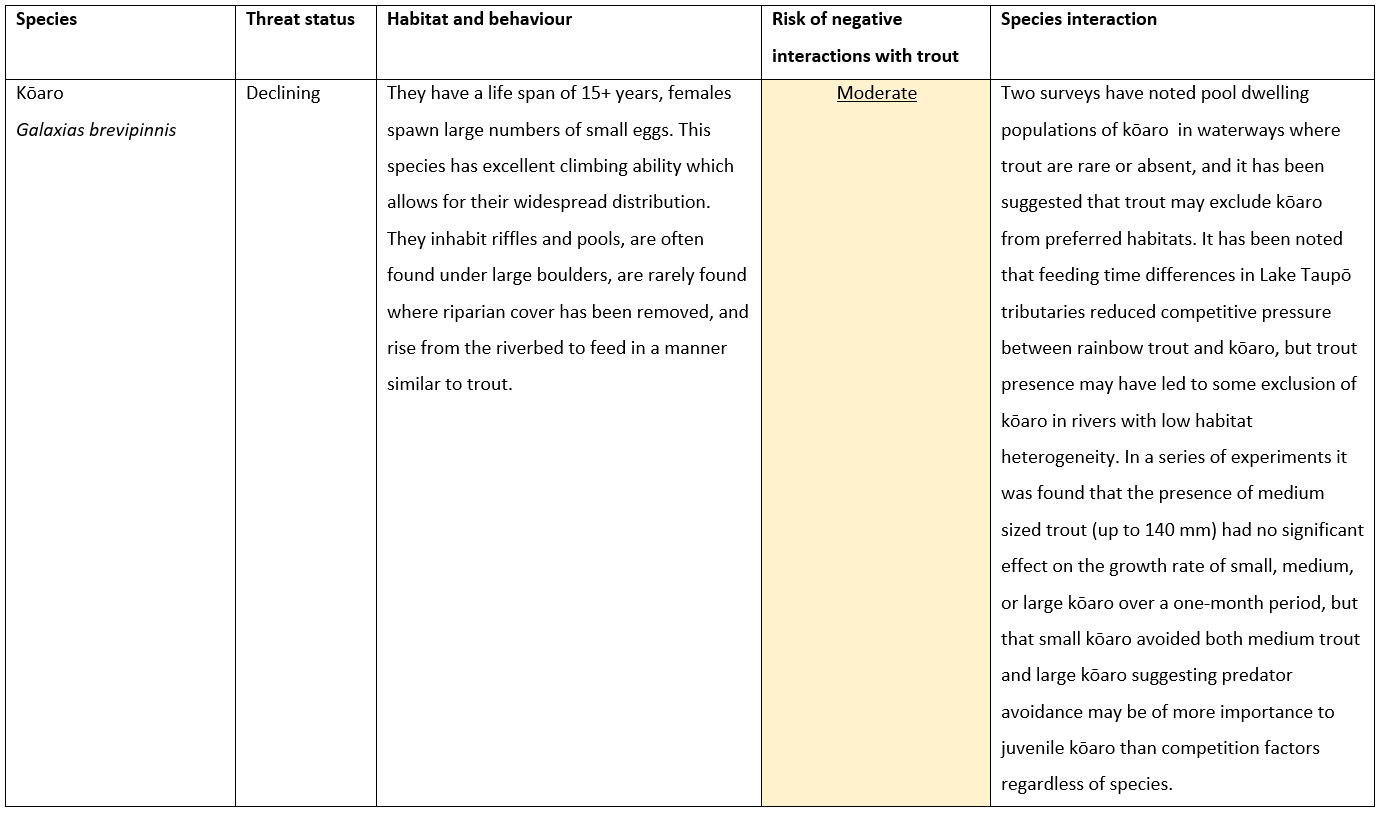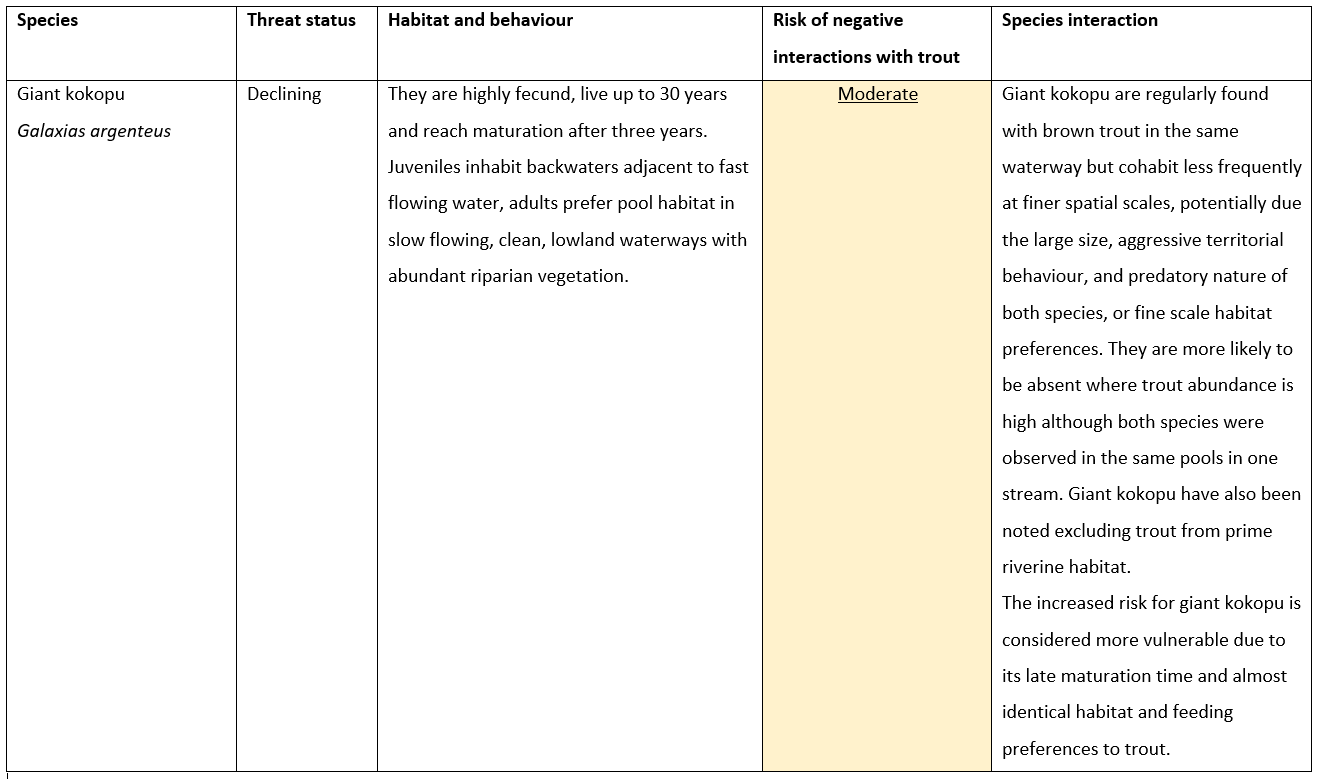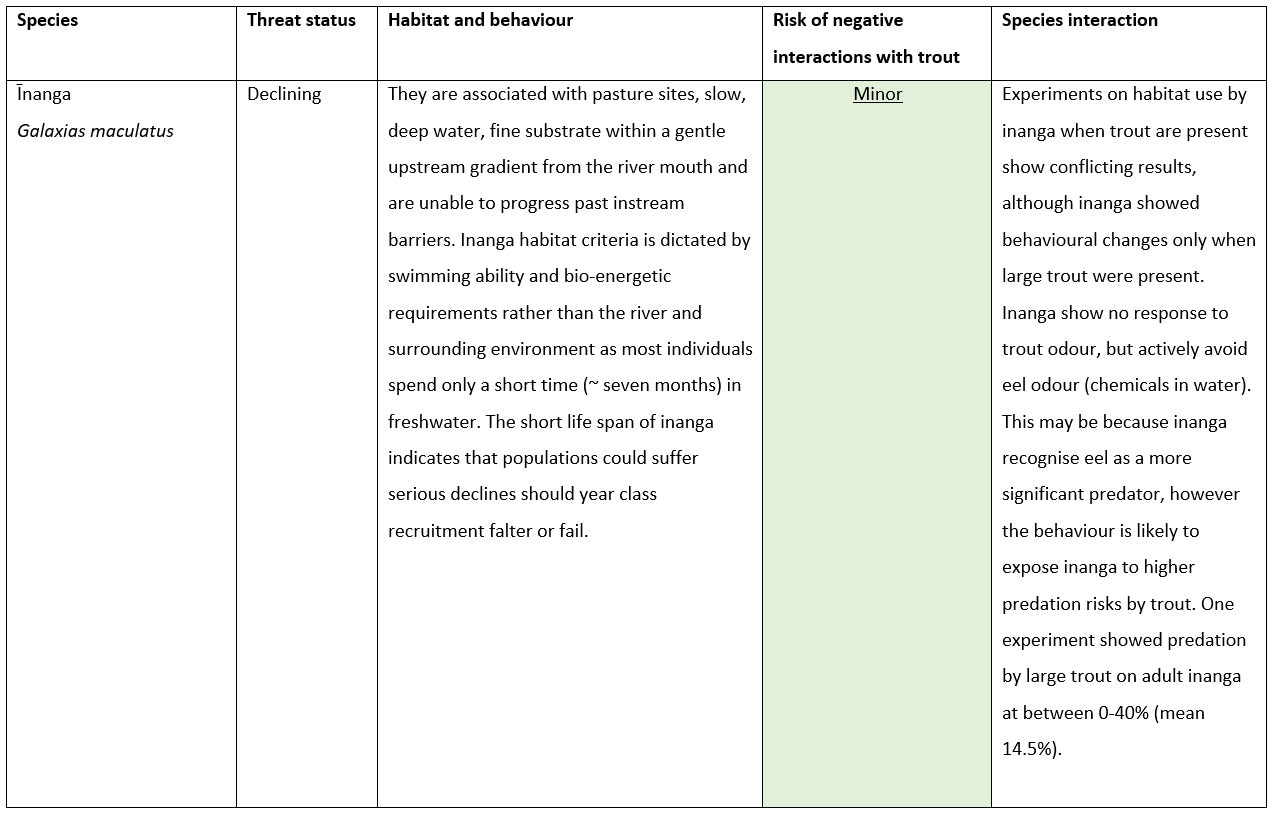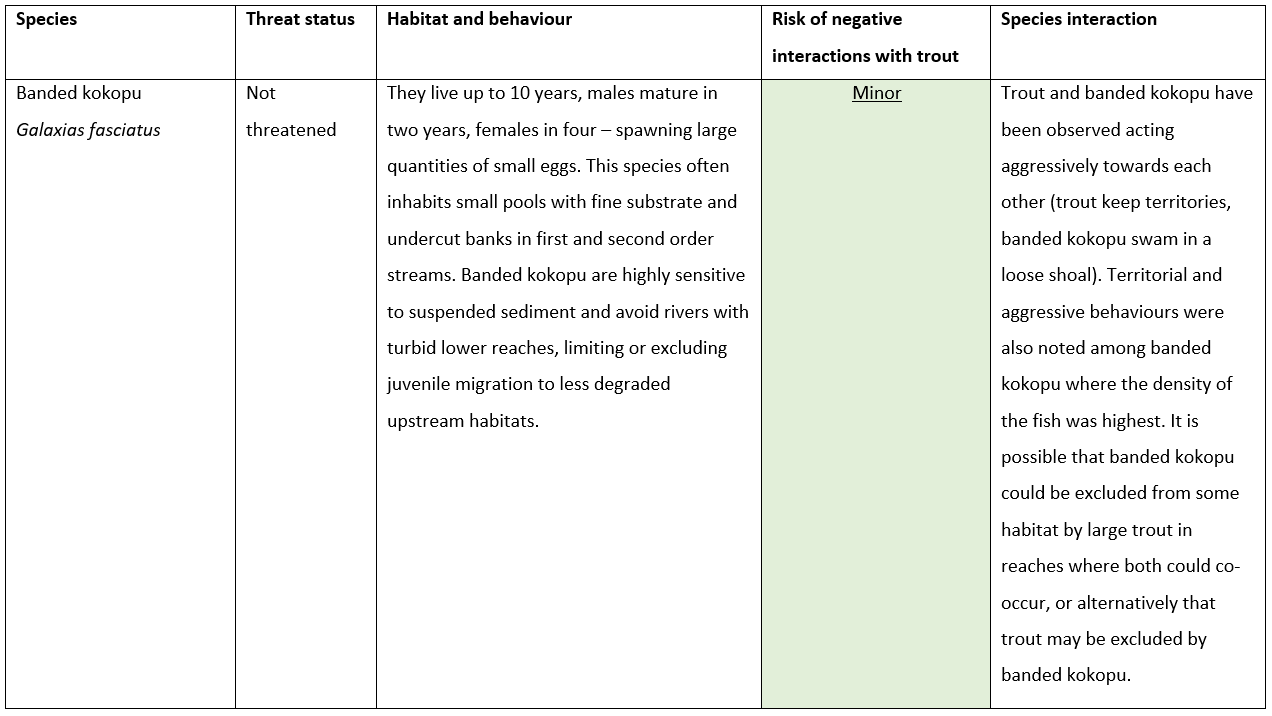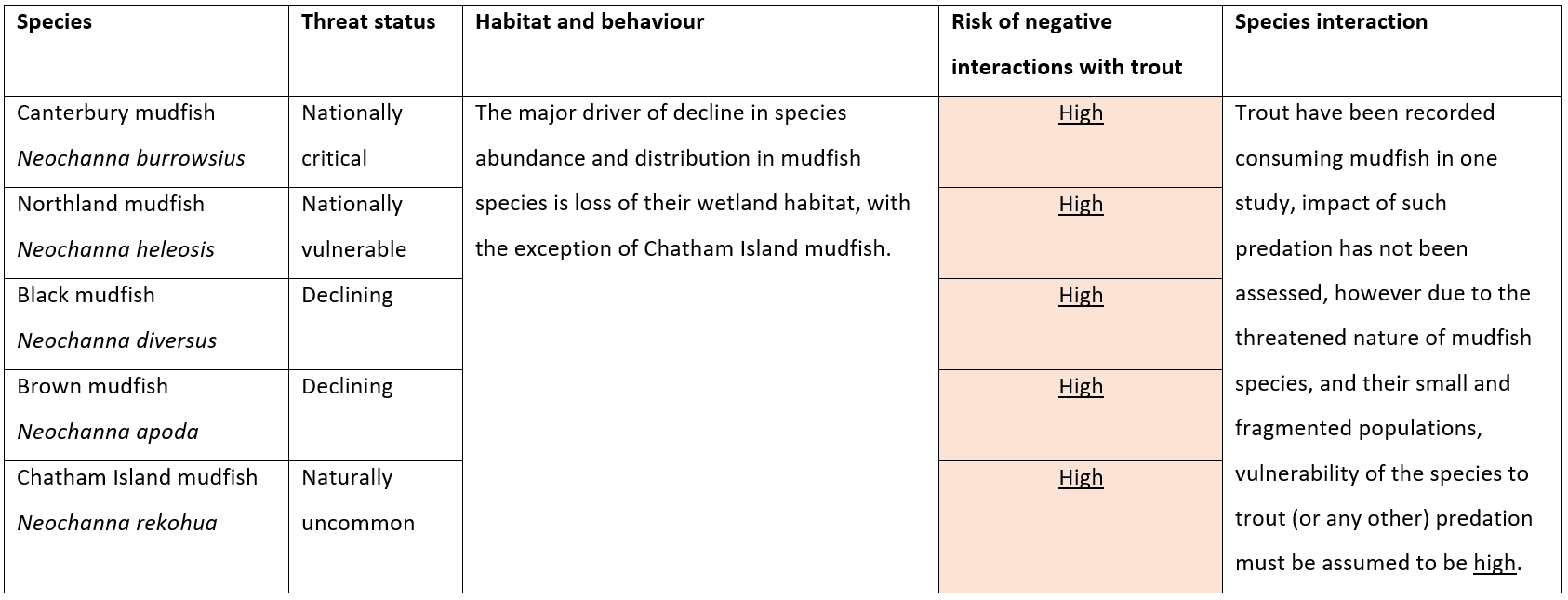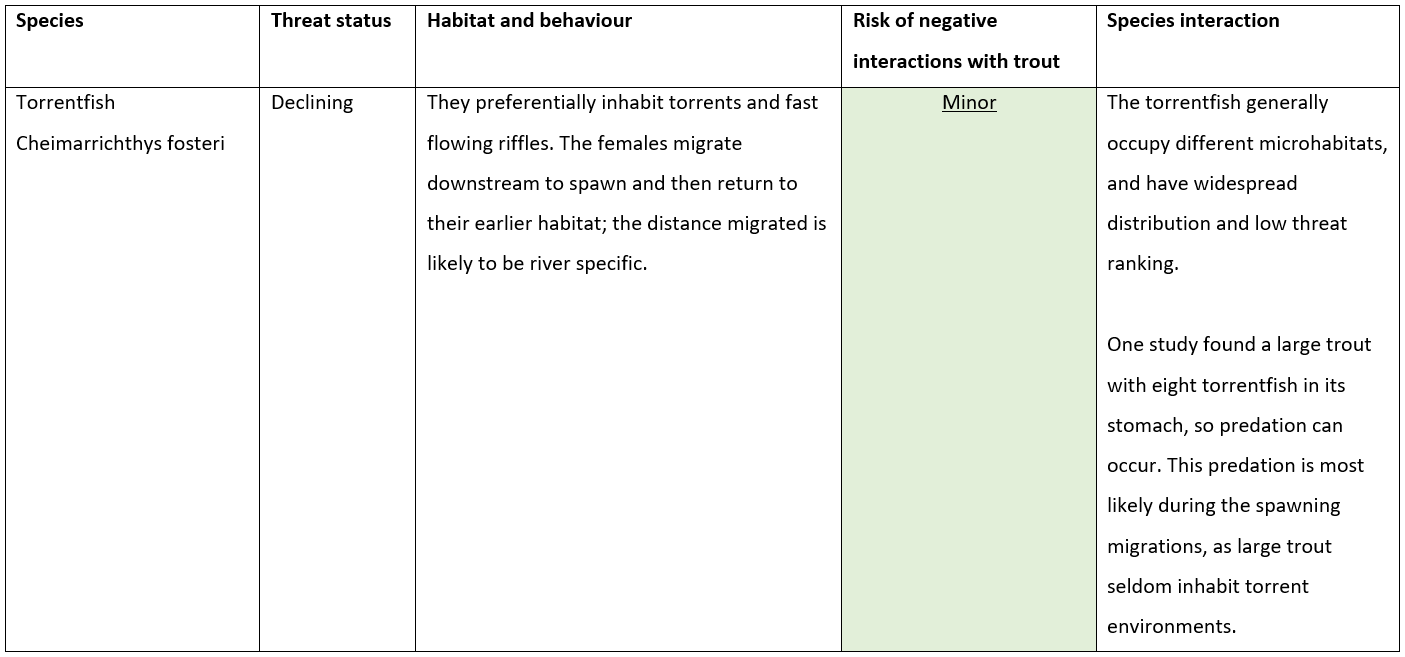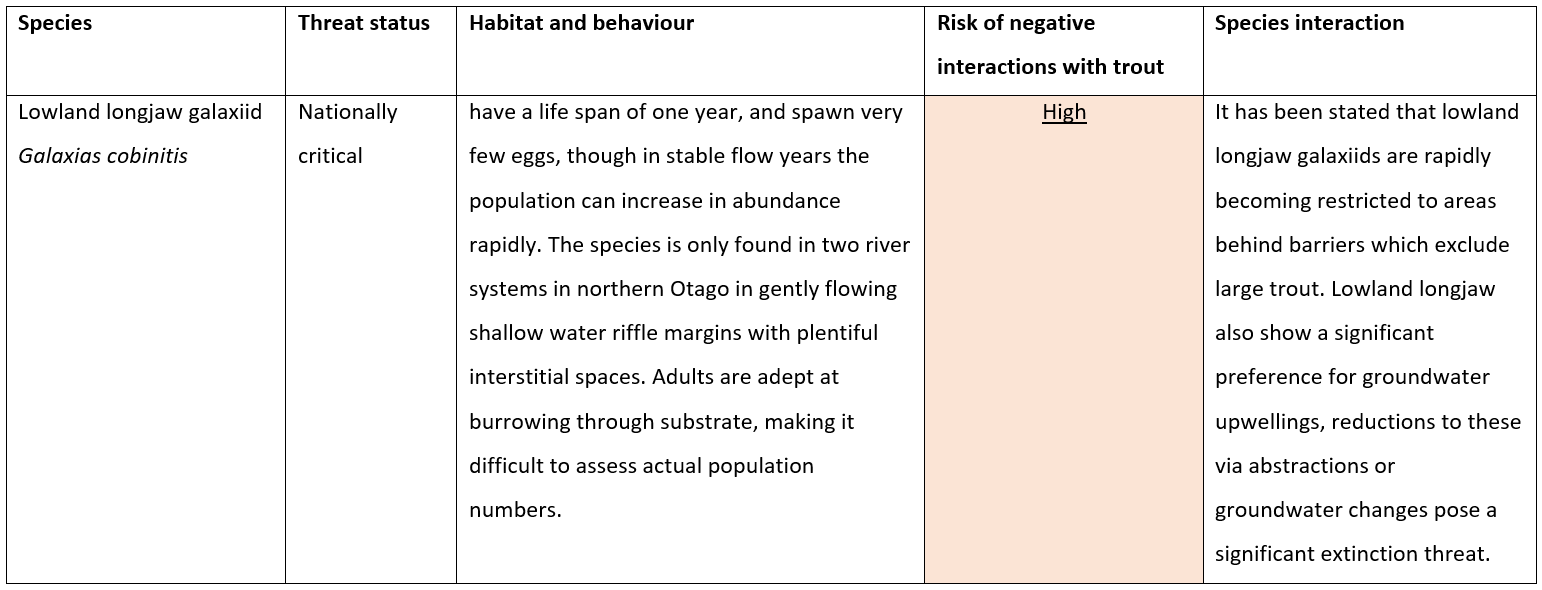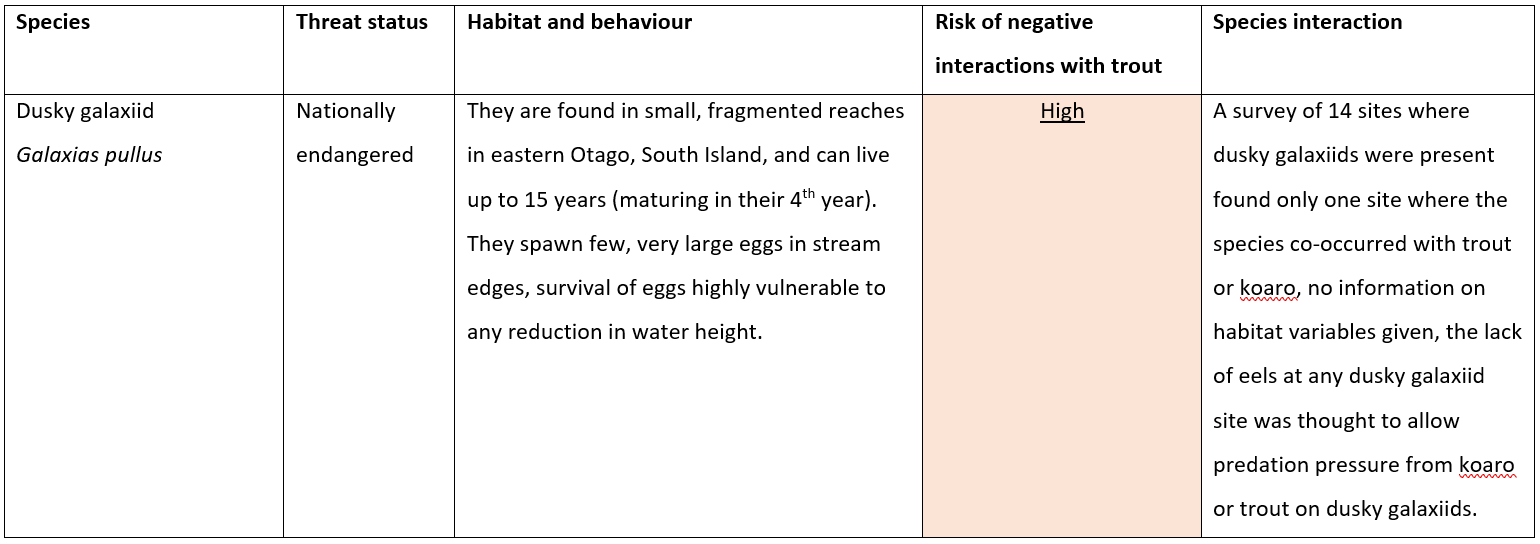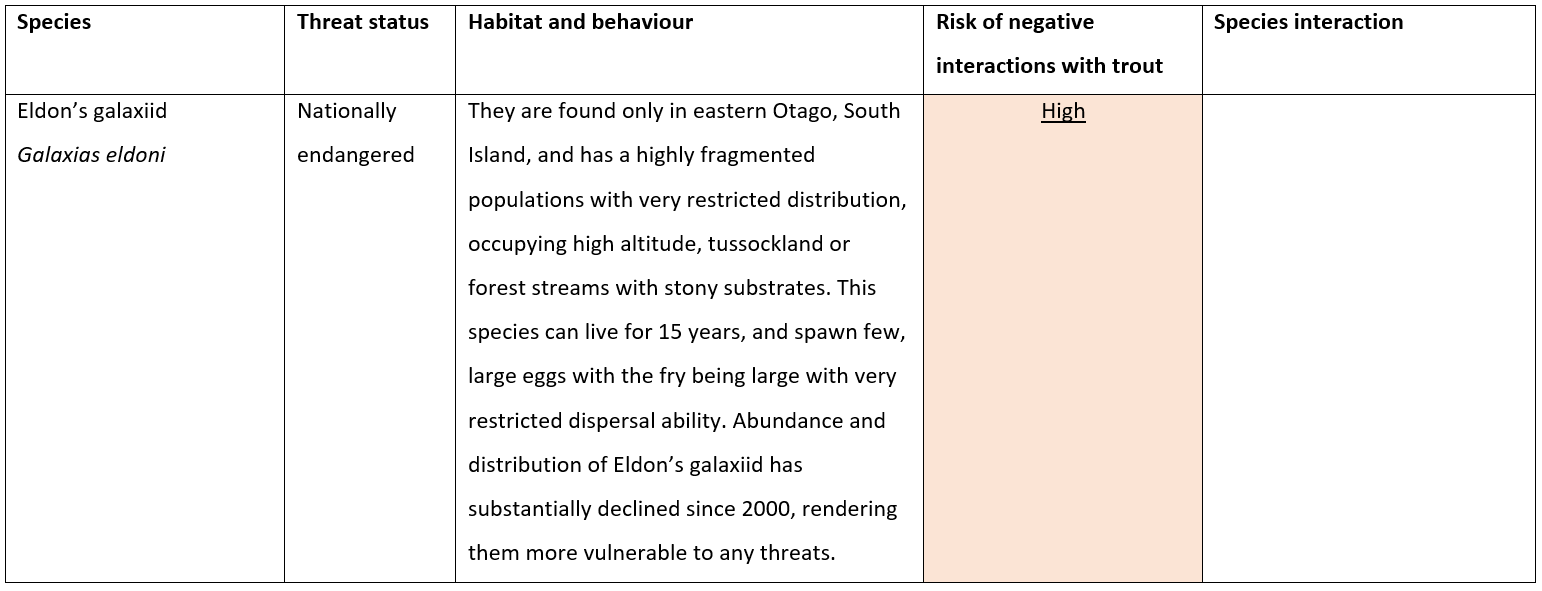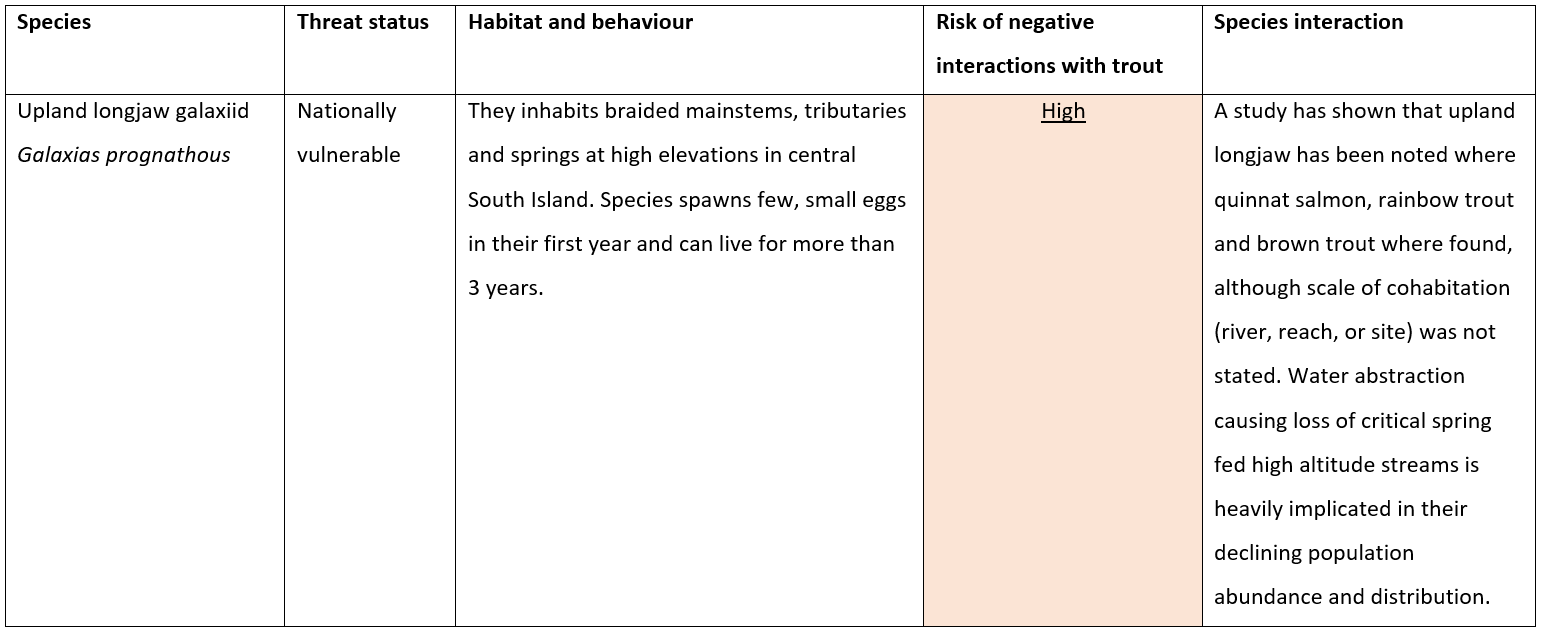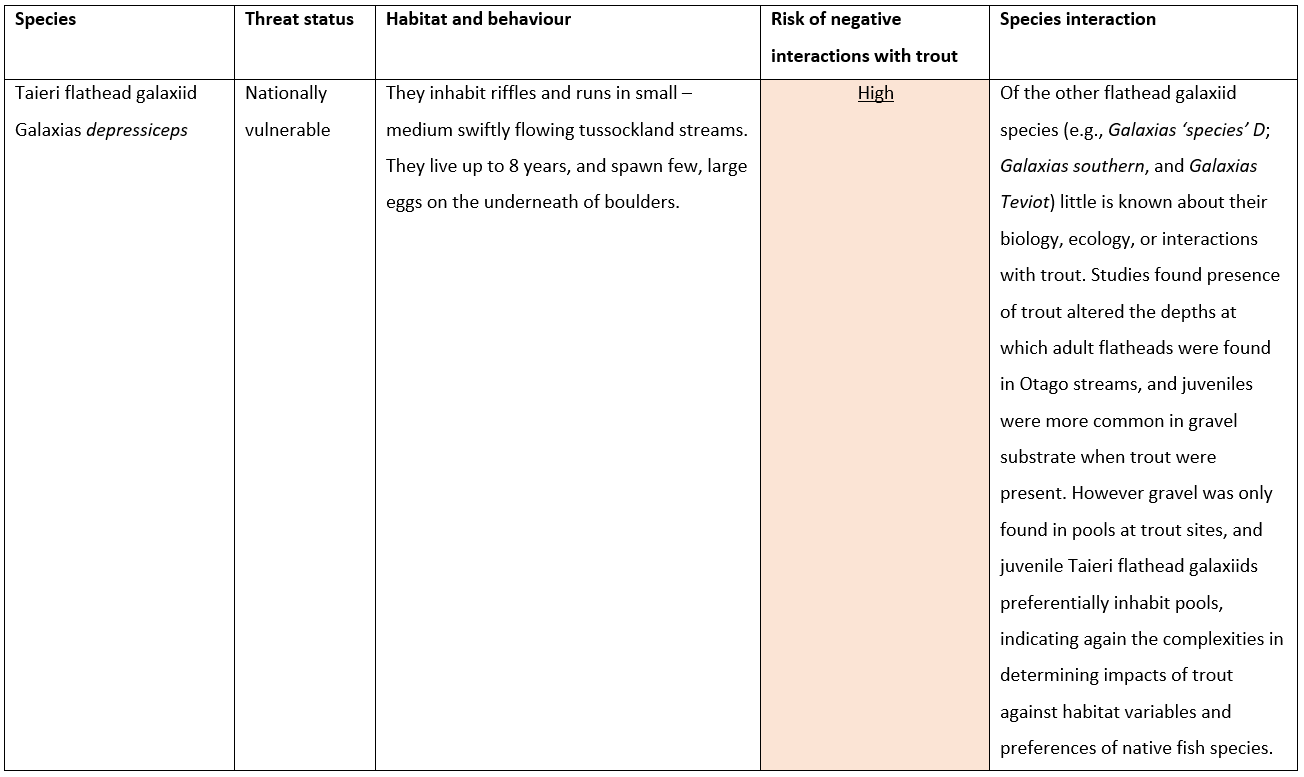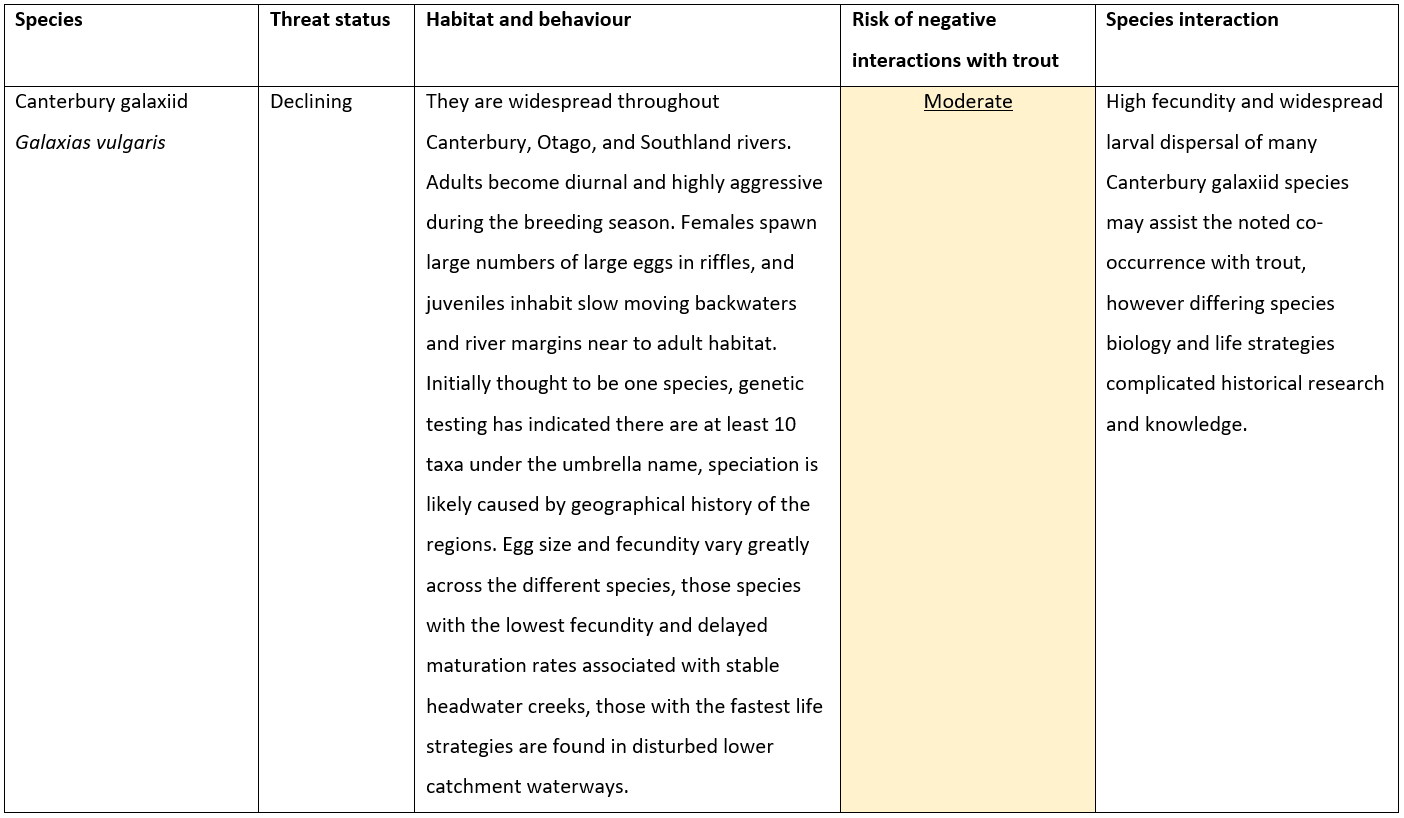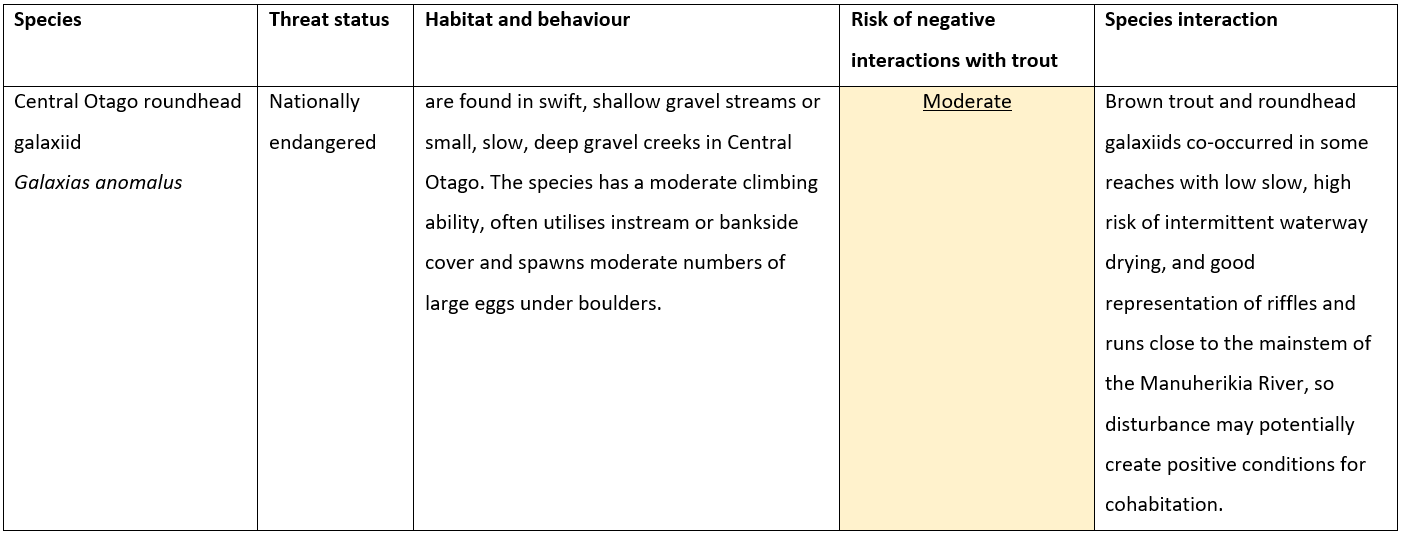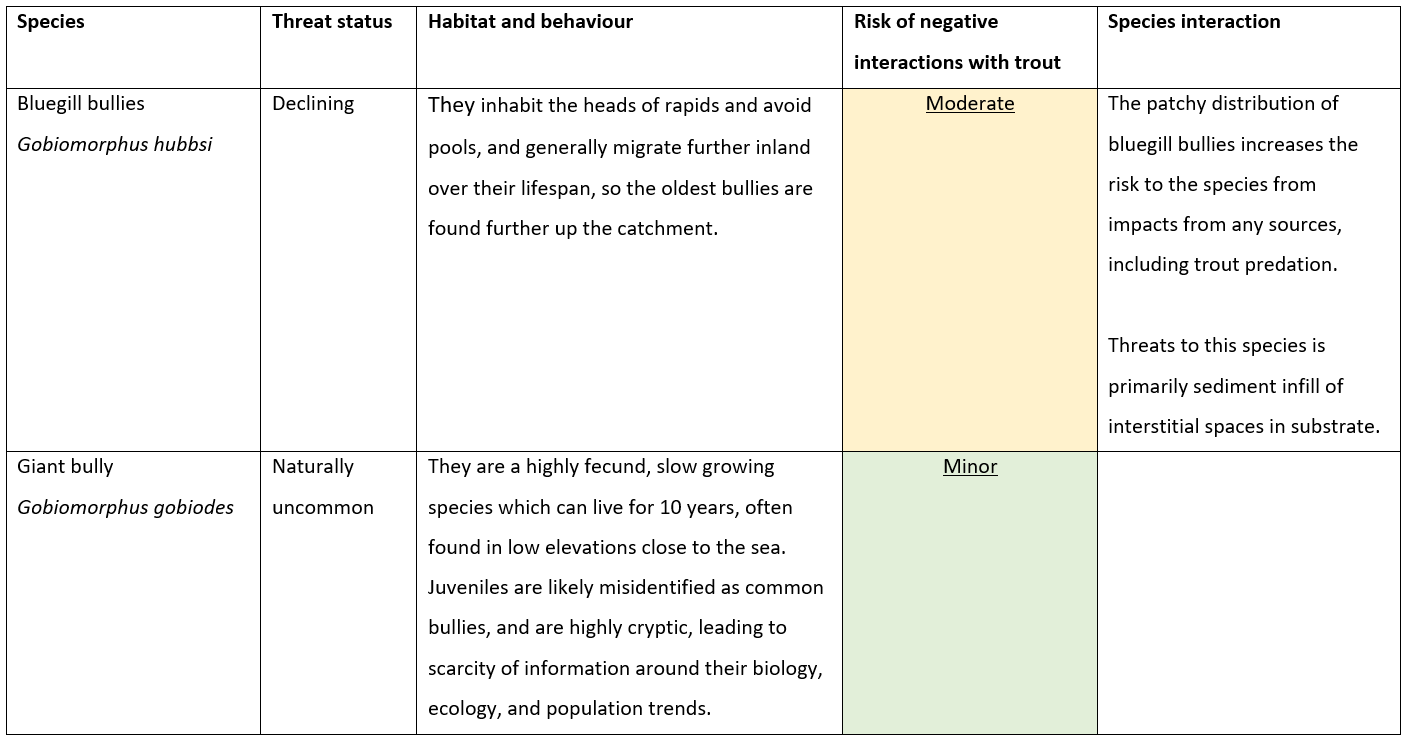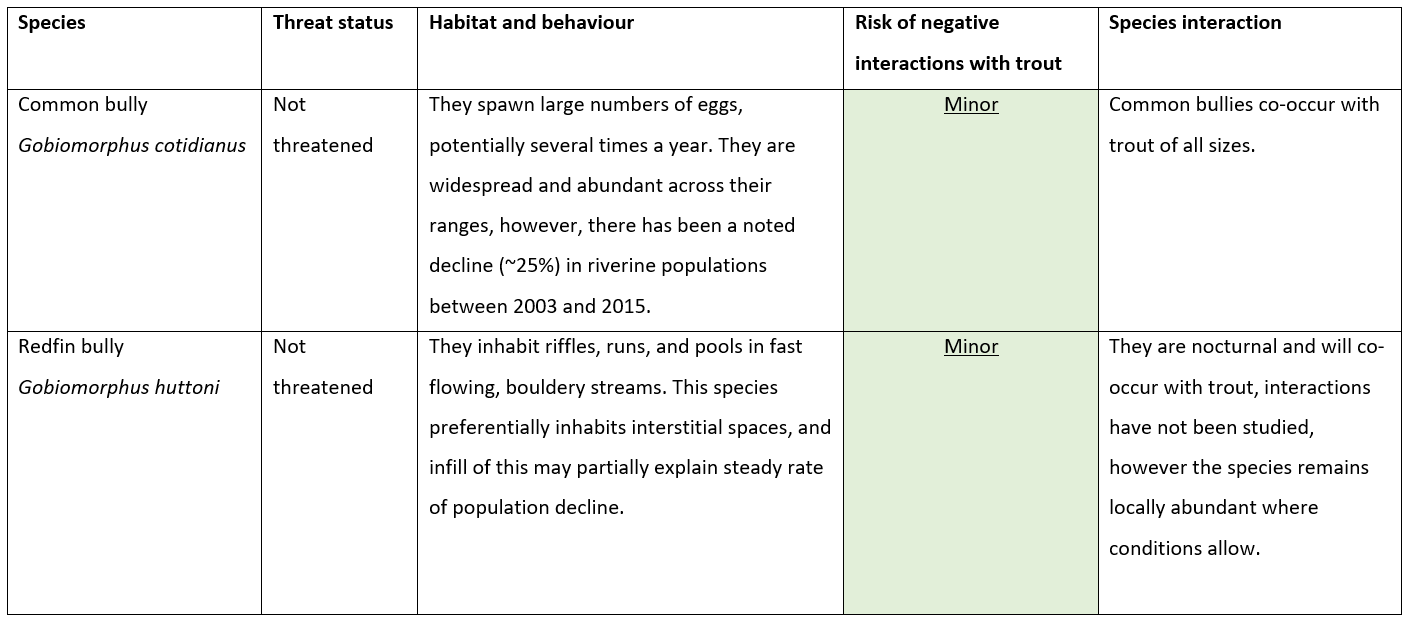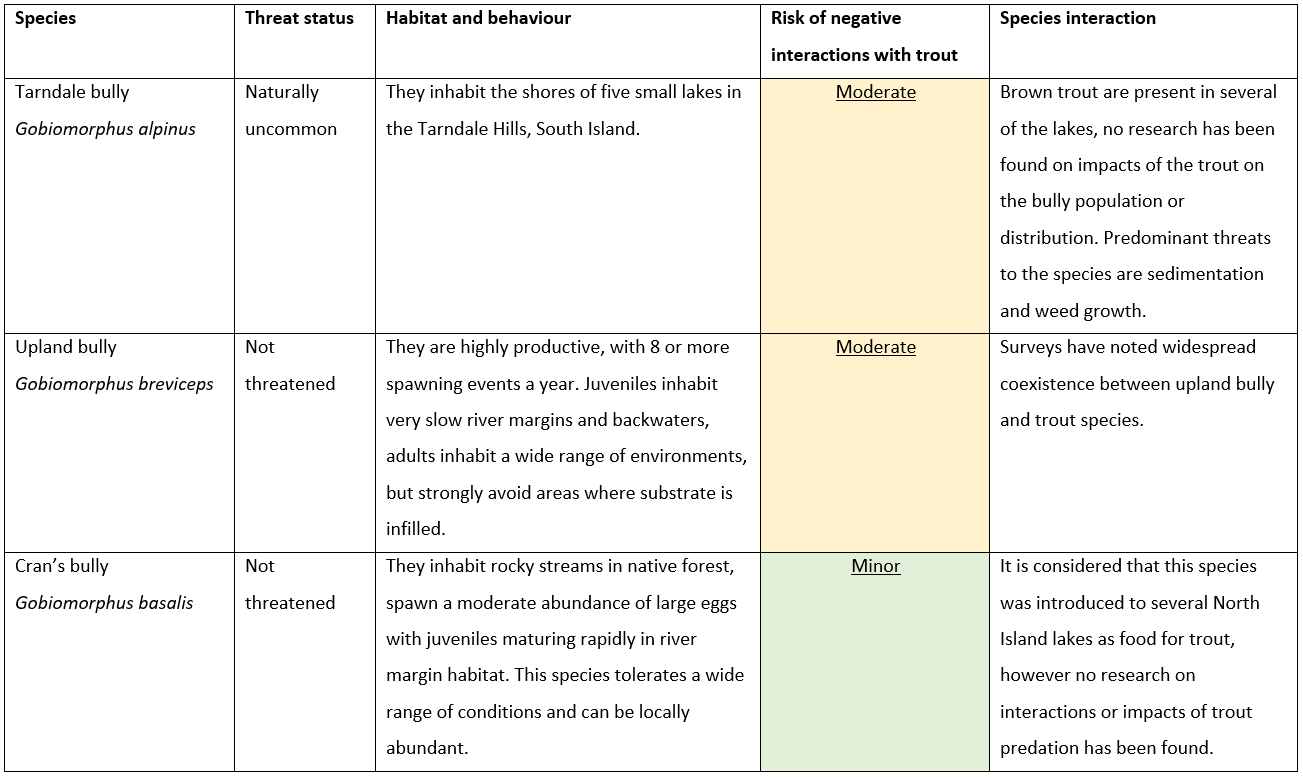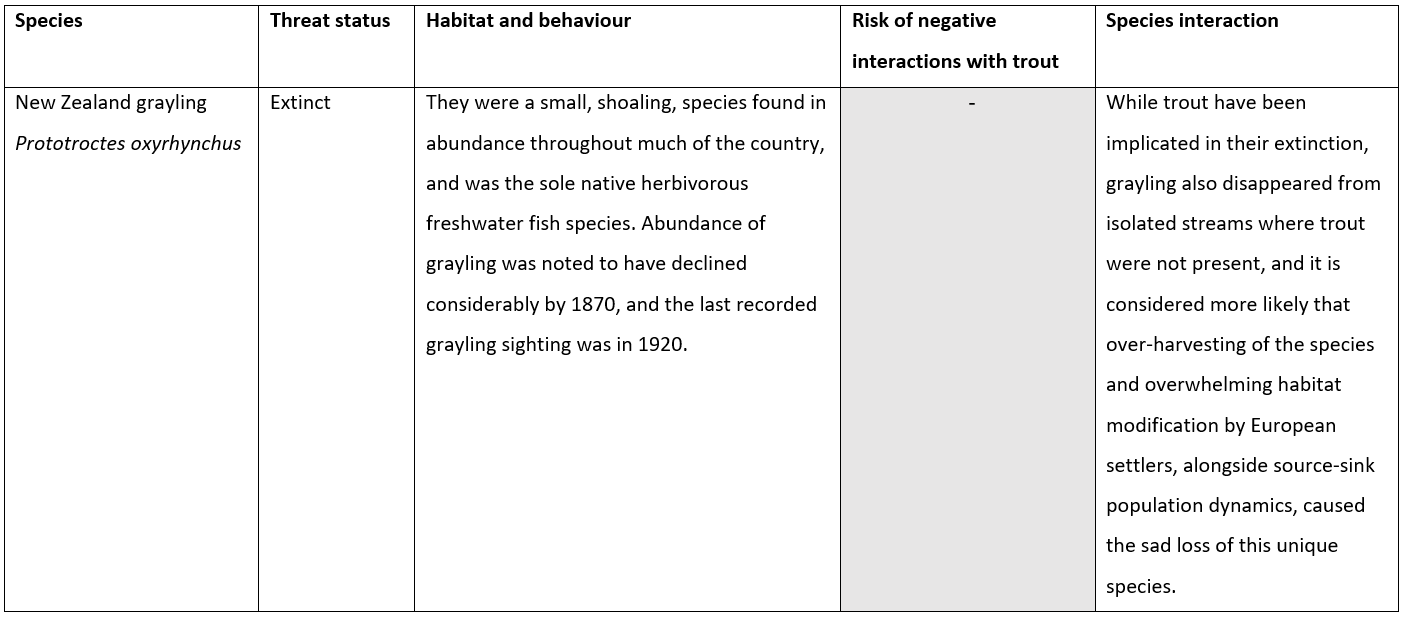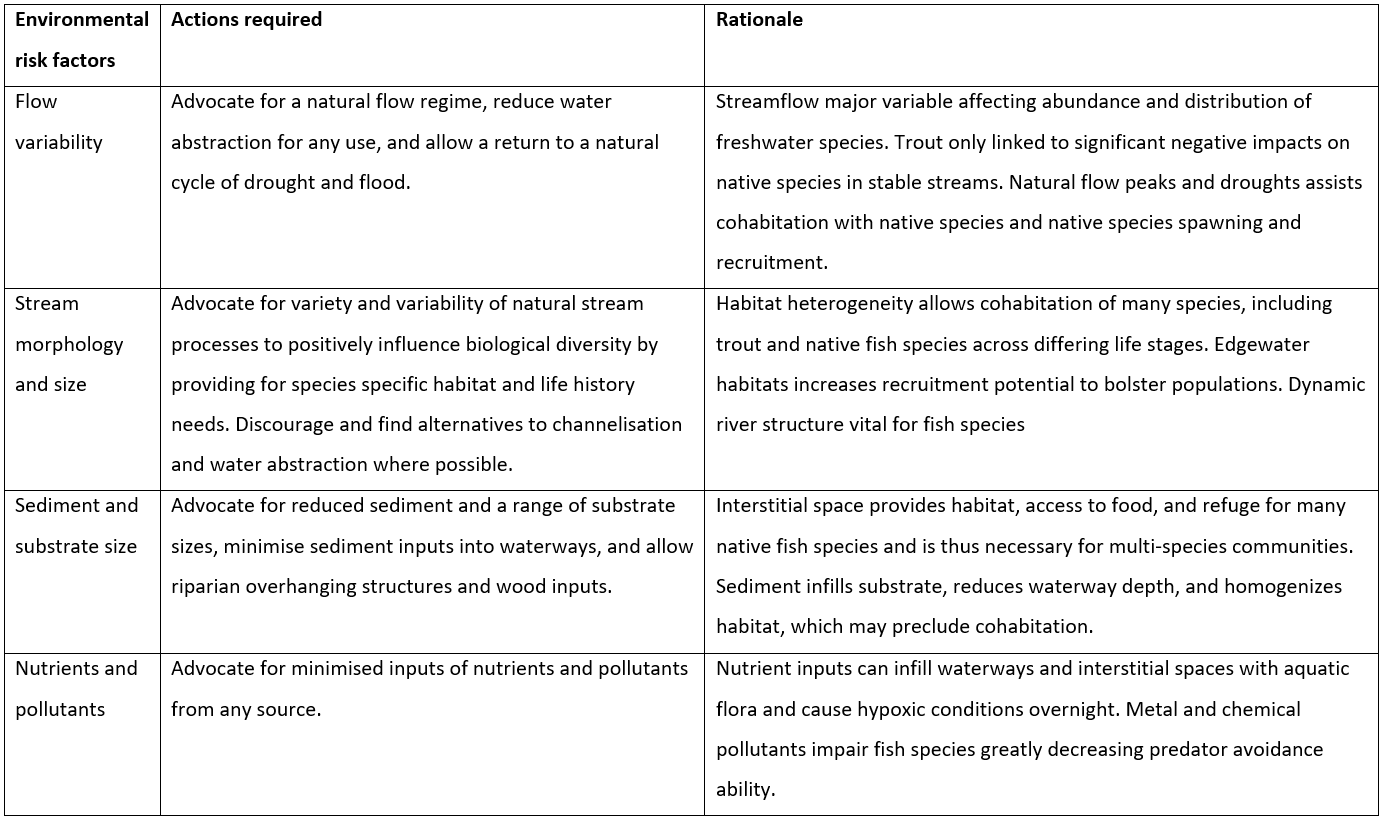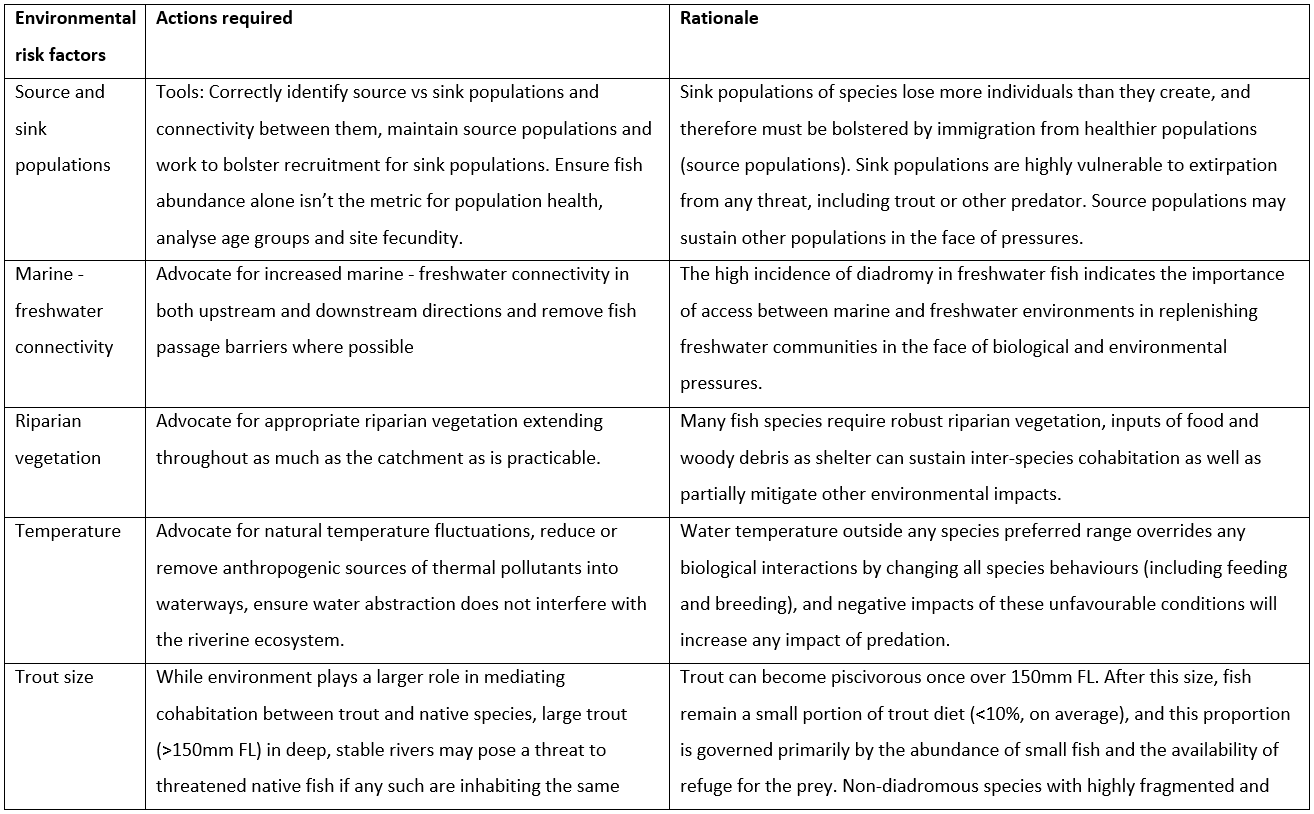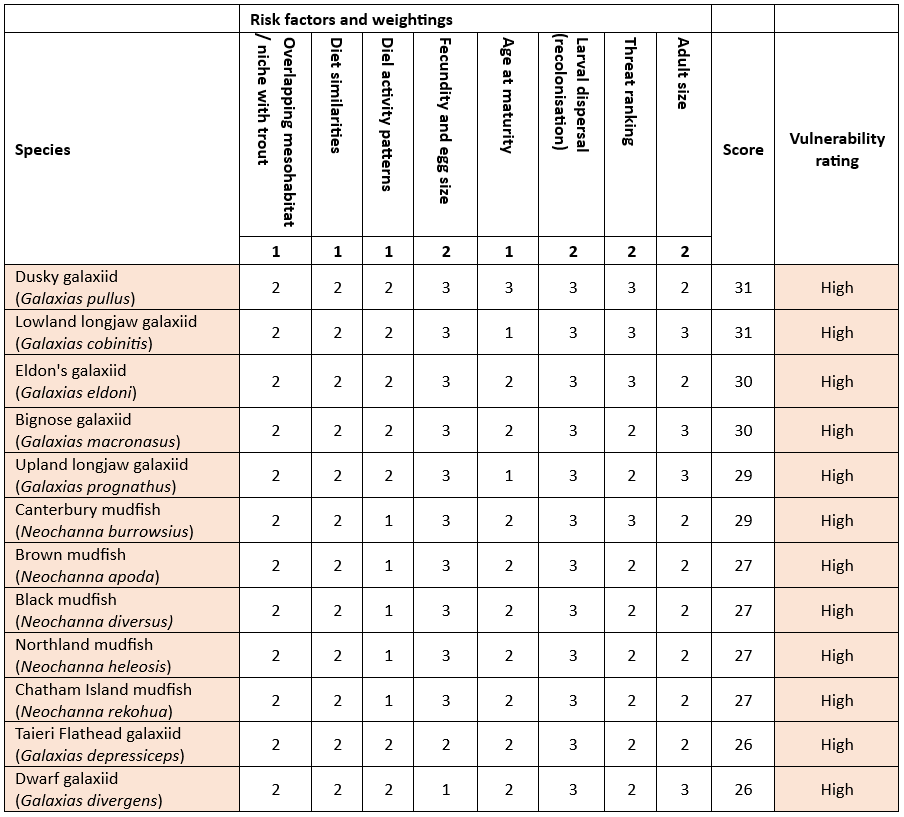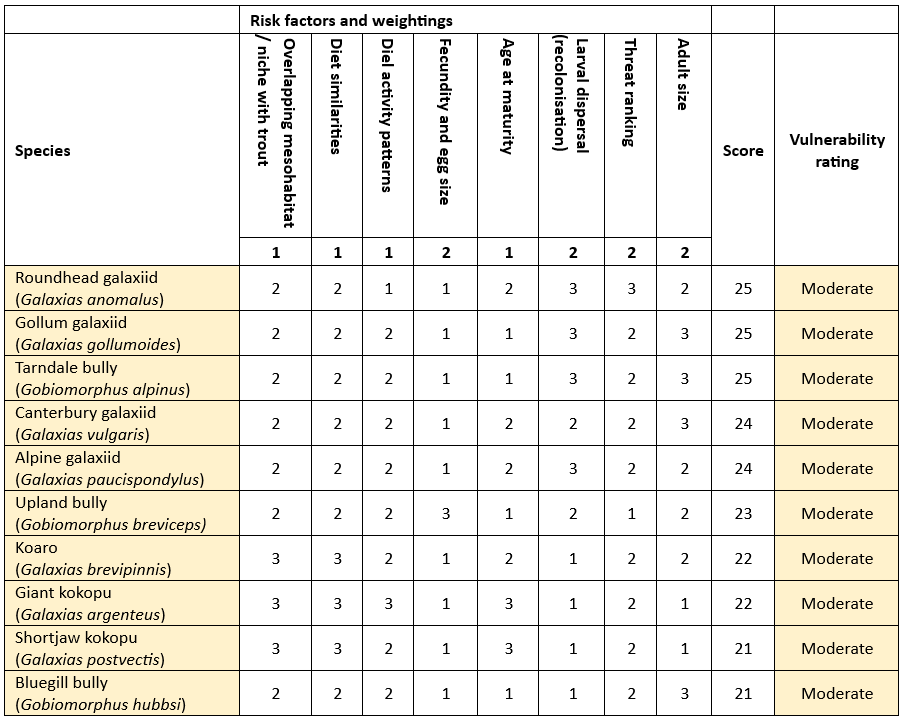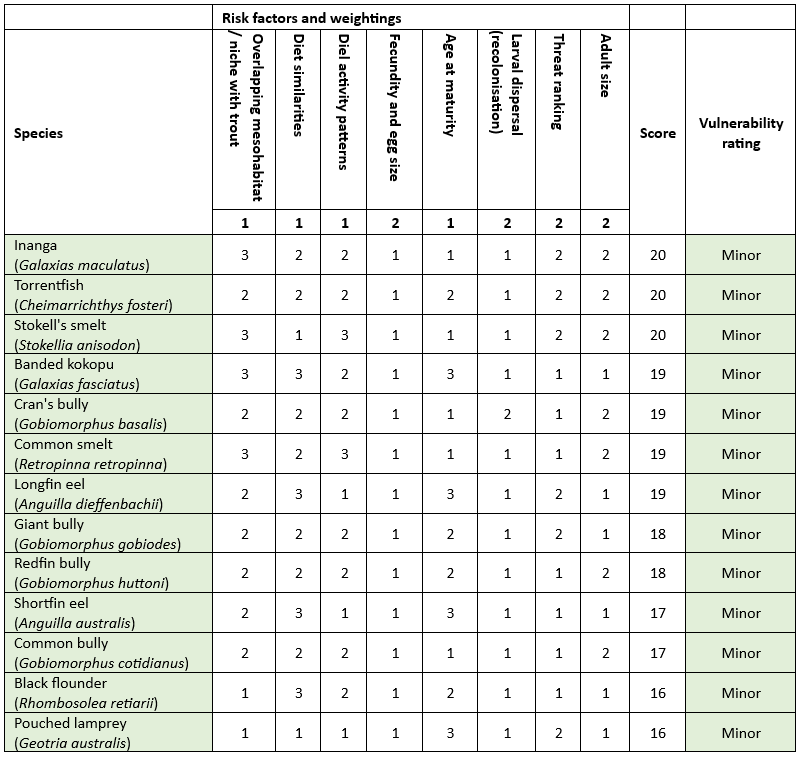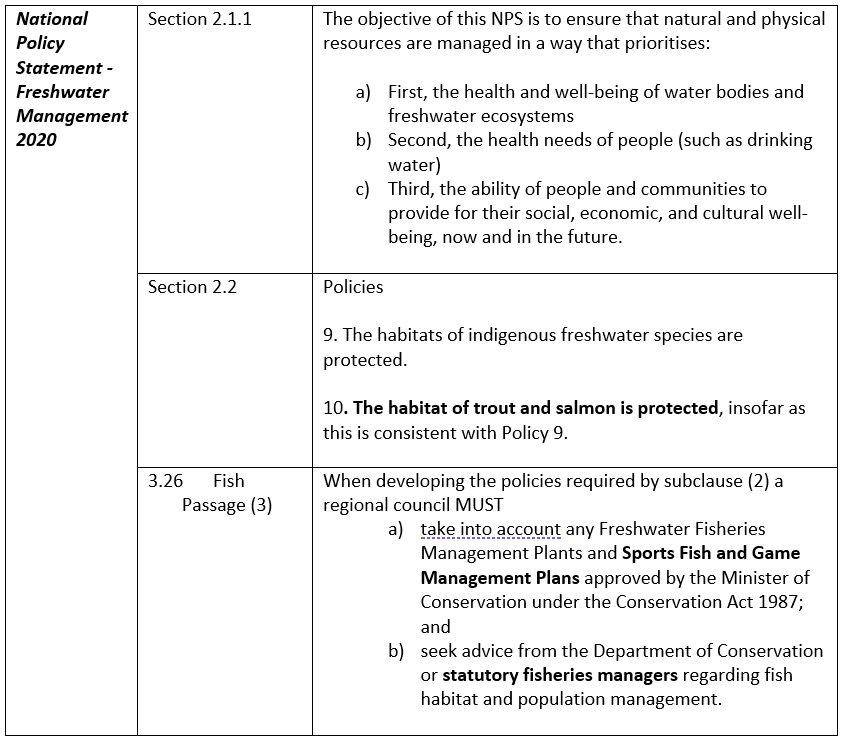Trout and Native Fish Species Interactions Resource
This resource is a condensed version of the thesis ‘Risk Assessment and Mitigations of the Potential Impacts of trout Predation on New Zealand’s Indigenous Fish Species’ (2022) by Ami Coughlan. It is primarily for resource managers to support them to implement the National Policy Statement for Freshwater Management 2020 (NPS-FM), specifically policies 9 and 10.
This resource provides a list of indigenous fish species that have been assessed against a Risk Assessment Matrix (RAM) criteria (Appendix 2) to determine the likely risk of trout species interaction having a negative impact on their population. This resource also includes strategies on what to do about it, and how to minimise any risks (Appendix 1).
Each species table details the risks of trout predation having a negative impact on native freshwater fish populations based on available biological and ecological research in flowing water. Each table gives a ranking of either high, moderate, or minor risk. Each table is ordered from the most endangered species down to species that are not threatened (see DOC conservation status information).
At a high level, the response to each level of risk is set out in the table below. This is high level advice, as a difference response may be appropriate in specific contexts, depending on the local information and circumstances. You should discuss the local response in detail with the Department of Conservation and Fish & Game.
Negative interactions between any freshwater fish species and any predator / competitor will become worse when the environment they both live in is degraded. The best way to minimise negative interactions between trout and salmon and indigenous species is to provide an abundance of diverse, good quality habitat. This means lots of clean, clear, cool water, and plenty of instream pools, runs and riffles.
Appendix 1 provides tools to help mitigate possible trout predation impacts on indigenous freshwater species. The strategies outlined in Appendix 1 are anticipated to help reduce their level of risk in the ecosystem and lower their status as a threatened species. All species will require monitoring, but the tools set out in Appendix 1 provide direction on how to respond to identified negative species interaction.
Where species are at a minor risk of negative population level impacts from trout predation, efforts to protect and enhance their habitat should still be encouraged, as this will ensure biological interactions remain low risk.
The RAM risk factors and weightings are transparent. These tables and the framework designed to deliver the risk results (vulnerability rating in Appendix 2) will need to be updated as any species risk status changes, and as future information regarding the biological and ecological needs of freshwater species becomes available, as necessary. This will help ensure efforts continue to refocus on the most critical species according to the RAM.
Species marked with an asterix (*) are species we are aware of that may be identified by tangata whenua as mahinga kai species. Management responses that are necessary to address any impacts on these species must be informed by engagement with tangata whenua in these locations.
Smelt*
Using the RAM, it is considered the risk of negative interactions with trout to be harmful to either smelt species populations is minor.
Eel*
Using the RAM, it is considered the risk of negative interactions with trout in causing harm to either eel populations is minor.
Pouched Lamprey*
Using the RAM, it is considered the risk of negative interactions with trout to be harmful to pouched lamprey populations is minor.
Black Flounder*
Using the RAM, it is considered the risk of negative interactions with trout to be harmful to black flounder populations is minor.
Diadromous galaxiids (whitebait species)*
Using the RAM, it is considered the risk of negative interactions with trout to be harmful to inanga and banded kokopu populations is minor, and shortjaw kokopu, giant kokopu and kōaro populations is moderate.
Giant kokopu, kōaro, inanga and banded kokopu populations can preferentially recruit within freshwater or estuarine systems. Shortjaw kokopu does not appear capable of forming landlocked populations.
Populations which preferentially breed in freshwater are at greater risk of negative impacts from anthropogenic activities than those who incorporate a marine life phase. The large bodied diadromous galaxiid species (giant kokopu, shortjaw kokopu, banded kokopu, and kōaro) are slow growing and strongly favour habitat with riparian vegetation.
The increased moderate risk to shortjaw kokopu, giant kokopu and koaro reflects broad dietary, habitat and feeding habits that overlaps with trout, as well as the increased vulnerability to predation encountered by migrating galaxiids (especially juveniles), and the potential for competitive exclusion. This may partially explain limited co-occurrence patterns between the species. Habitat preferences and environmental variables will impact on spatial distributions of the species also. Populations of diadromous galaxiid species have also suffered major declines in areas where river channelisation, deforestation, wetland drainage and conversion of land to pasture have occurred.
If trout and diadromous galaxiids species are found to interact within the same freshwater body, these vulnerabilities may be offset by differences in microhabitat (i.e. the finer details of habitats used by different species such as pools or riffles, where there is a variety of quality habitat more species can coexist) and diel feeding preferences (i.e. the time of day that species typically undertake activities such as feeding, sleeping etc); the four large diadromous galaxiids species are likely to grow too big to be consumed by trout and have been observed excluding trout from preferred habitat.
Mudfish species
The RAM considers that due to the threatened nature of mudfish species, and their small and fragmented populations, vulnerability of the species to trout (or any other) predation must be assumed to be high.
Torrentfish
Using the RAM, it is considered the risk of negative interactions with trout to be harmful to torrentfish populations is minor.
Non-diadromous galaxiids
The RAM considers risk of trout predation to populations of Central Otago roundhead, Gollum, Canterbury and alpine galaxiids to be moderate, and the risk to dwarf, upland longjaw, lowland longjaw, Eldon’s, dusky, and the bignose and Taieri flathead galaxiids to be high.
These are galaxiid species which spend their entire life cycles in freshwater systems, and often have larger eggs and fry in comparison with diadromous galaxiids. They are generally cryptic and relatively unstudied, with many species only described recently based on genetic analysis (past research talks about certain species which are found later to be separate species, further confounding results of the studies).
Trout and non-diadromous galaxiids have been found coexisting in some sites particularly in locations with higher level of disturbance size and frequency, interstitial or vegetation refuges, and those sites of a size which excludes large trout. While some studies discuss the predominance of some non-diadromous galaxiid species presence above barriers to trout, non-overlapping distributions of non-diadromous species have also been noted to occur due to geomorphological changes brought about by geological and glacial processes which have isolated populations and led to the speciation noted.
There are broad diet and habitat overlaps between non diadromous galaxiids and trout, the small size of these indigenous species increases risk of predation. Those species with slower life strategies, delayed maturation, and high threat ranking are at an increased risk to any form of disturbance (biological or habitat based). While the literature is not clear on the impact trout can have, habitat preservation and restoration, and reduction of all threats to these species are of utmost importance.
If trout and galaxiid species are found to interact within the same freshwater body, the precautionary principle should be used where species are highly threatened, fragmented, or have slow life strategies and late maturation which can lead to unrecoverable population impacts by any means (predation by fish or birds, or loss of habitat).
Diadromous bully species
The RAM considers the risk of trout predation to be deleterious to common, giant, and redfin bully populations to be minor, and for bluegill bullies to be moderate. Bully species have high fecundity, multiple spawning events in a year, early maturation, wide larvae dispersal, and nest guarding behaviours which contribute to abundance and distribution of the species.
Like the diadromous galaxiids, diadromous bullies migrate between freshwater and marine environments at different stages of their life cycles. Adult bullies are benthic and occupy a wide range of habitats, the female bullies lay eggs on or under any hard surface.
Non-diadromous bully species
The RAM considers the risk of trout predation to be deleterious to Cran’s bully populations to be minor, and for upland and Tarndale bully populations to be moderate. All species have been noted to co-occur with trout, however upland and Tarndale bullies are geographically isolated with fewer recruitment opportunities, and thus more vulnerable to any negative impacts.
Non migratory bully species live their life cycles in freshwater, and generally spawn larger eggs than diadromous bully species.
Grayling
The New Zealand grayling are the only native fish species known to become extinct. As outlined in the table below, while there has been speculation that extinction was from trout, there is no evidence of this as trout were not present in many of the locations where grayling became extinct. This example is included as a reminder that evidence of species interaction and the implication of a negative risk to indigenous freshwater species is critical to understand in each particular reach before mitigation measures are decided at the local water body level. Speculative, and historical assumptions must be questioned and decisions based on best information available.
Appendices
Appendix 1: Tools to moderate possible impacts of trout predation on indigenous freshwater fish species in rivers
Appendix 2: Risk Assessment Matrix
This RAM gives an objectively derived numeric score for each species based on an assessment of specific traits. The impact trout predation has on the population of each native species depends on frequency and extent of interactions with trout, population dynamics, and behaviour. Literature on species life history (how rapidly species re-populate), biology, and ecology information were used to populate this RAM. Certain risk factors were seen as more likely to cause species to be more vulnerable than others, and these were given a weighting to show this. The scores derived from this information where then grouped into highly vulnerable, moderate, and minor risk groups. This ranking shows how vulnerable each species is likely to be to population level detrimental impacts of trout predation. Those threatened, fragmented, species are highly vulnerable to extinction or extirpation from any source and need to be protected from all threats. Where adults of a species remain small, they are more likely to be able to be eaten by trout or a larger fish. Species with a slow life strategy (spawning few, large, eggs, having a low dispersion rate of individuals or breeding maturity reached after many years) are more vulnerable to losses which contribute to smaller, fragmented, or less resilient populations. Species which mature quickly, spawn many small and mobile young, and/or disperse widely, tend to have populations which are more resilient to threats, including that of predation by trout.
Appendix 3: Current legislation under which Fish and Game advocate for the habitat of trout and salmon
The table below has bold text to emphasis the specific direction to protect trout and salmon habitat and ecosystem conditions.



